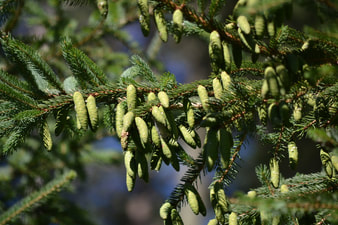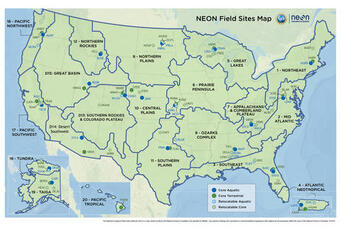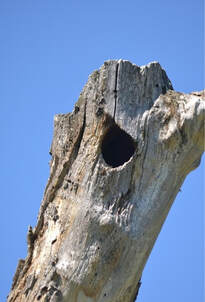
Spatial Synchrony, Macrosystems Biology, and Global Change:
We are working on describing and understanding patterns and drivers of variability and synchrony in dynamics across scales, from individuals and populations to continental and global scales, and how these will be affected by global change. We focus on two main systems, one related to mast seeding of tree species, which is key for forest regeneration, and the other involving dynamics of seed production linked to bird, small mammal, and tick population dynamics.
Mast seeding is the synchronous production of large seed crops by a population of plants. Seed production plays key roles in forest regeneration and are as a food source for a variety of seed consumers, such as small mammals, insects, and birds. There are a variety of hypotheses as to why mast seeding occurs, from evolutionary responses to satiate seed predators, or increase pollination efficiency; or it could result from resource-matching. Mast seeding patterns are highly linked to temperature, and there are a variety of predictions for what the influence of climate change will be on seed production. Our interest in mast seeding includes examining individual patterns of seed production over time and synchrony over space to ask how these individual patterns give rise to the population phenomenon, the similarities and differences in mast-seeding patterns of multiple species at a variety of scales, and the consequences of mast seeding patterns on forest dynamics and on species of seed consumers.
In 2012, my lab established a long-term study at 18 sites spanning spanning 30,000 km2,in three regions of the southern boreal-temperate forest ecotone to examine seed and cone production by almost 1,000 individually tagged white spruce trees, and this now includes multiple tree species. We are interested in levels of cone abundance between individuals within a site, between sites within a region, and between regions, and examining the roles of environmental factors on patterns of cone production, and relationships between cone production and tree defoliation. In addition to field data, we use continental and global-scale datasets to address research questions. This project is funded by the National Science Foundation.
We are working on describing and understanding patterns and drivers of variability and synchrony in dynamics across scales, from individuals and populations to continental and global scales, and how these will be affected by global change. We focus on two main systems, one related to mast seeding of tree species, which is key for forest regeneration, and the other involving dynamics of seed production linked to bird, small mammal, and tick population dynamics.
Mast seeding is the synchronous production of large seed crops by a population of plants. Seed production plays key roles in forest regeneration and are as a food source for a variety of seed consumers, such as small mammals, insects, and birds. There are a variety of hypotheses as to why mast seeding occurs, from evolutionary responses to satiate seed predators, or increase pollination efficiency; or it could result from resource-matching. Mast seeding patterns are highly linked to temperature, and there are a variety of predictions for what the influence of climate change will be on seed production. Our interest in mast seeding includes examining individual patterns of seed production over time and synchrony over space to ask how these individual patterns give rise to the population phenomenon, the similarities and differences in mast-seeding patterns of multiple species at a variety of scales, and the consequences of mast seeding patterns on forest dynamics and on species of seed consumers.
In 2012, my lab established a long-term study at 18 sites spanning spanning 30,000 km2,in three regions of the southern boreal-temperate forest ecotone to examine seed and cone production by almost 1,000 individually tagged white spruce trees, and this now includes multiple tree species. We are interested in levels of cone abundance between individuals within a site, between sites within a region, and between regions, and examining the roles of environmental factors on patterns of cone production, and relationships between cone production and tree defoliation. In addition to field data, we use continental and global-scale datasets to address research questions. This project is funded by the National Science Foundation.

Macrosystems research
At continental to global scales, we are interested in how ecological patterns emerge, particularly those arising from large-scale climatic patterns, and the phenomenon of 'ecological dipoles' that are revealed by anti-synchrony in dynamics between spatially separated sites.
This work uses a combination of continental and global databases on mast seeding to look at patterns of variability and synchrony across scales and its association with climate drivers. We also use existing citizen science datasets along with NEON data, and working with Dr. Ben Zuckerberg (UW-Madison) and Dr. Court Strong (University of Utah) on a Macrosystems-level project to link together climatic patterns with population dynamics and synchrony in animal and plant populations at the continental scale. We are using data on birds, small mammals, tick abundance, and seed production datasets across continental North America. This project is funded by the National Science Foundation.
Dr. LaMontagne is the lead-PI of a Long-Term Ecological Research (LTER) Synthesis working group on the topic of 'Environmental Drivers of Plant Reproduction'. The group has harmonized long-term woody plant reproduction data from US LTER sites spanning Puerto Rico to Alaska and is asking questions about community-level synchrony, and how mast seeding drivers vary across disparate biomes. This work is funded by NSF and the NSF Long-Term Network Office (LNO) and is hosted at the National Center for Ecological Analysis and Synthesis (NCEAS).
At continental to global scales, we are interested in how ecological patterns emerge, particularly those arising from large-scale climatic patterns, and the phenomenon of 'ecological dipoles' that are revealed by anti-synchrony in dynamics between spatially separated sites.
This work uses a combination of continental and global databases on mast seeding to look at patterns of variability and synchrony across scales and its association with climate drivers. We also use existing citizen science datasets along with NEON data, and working with Dr. Ben Zuckerberg (UW-Madison) and Dr. Court Strong (University of Utah) on a Macrosystems-level project to link together climatic patterns with population dynamics and synchrony in animal and plant populations at the continental scale. We are using data on birds, small mammals, tick abundance, and seed production datasets across continental North America. This project is funded by the National Science Foundation.
Dr. LaMontagne is the lead-PI of a Long-Term Ecological Research (LTER) Synthesis working group on the topic of 'Environmental Drivers of Plant Reproduction'. The group has harmonized long-term woody plant reproduction data from US LTER sites spanning Puerto Rico to Alaska and is asking questions about community-level synchrony, and how mast seeding drivers vary across disparate biomes. This work is funded by NSF and the NSF Long-Term Network Office (LNO) and is hosted at the National Center for Ecological Analysis and Synthesis (NCEAS).
|
Global Change Biology:
Climate change Reproduction in trees is influenced by temperature, and increased CO2 due to climate change may provide a fertilizing effect on trees. Of course, there are many changes that will happen in boreal ecosystems as the climate changes, including impacts on soil water availability and nutrients for uptake that may produce indirect effects of temperature on tree reproduction. In 2017, Dr. LaMontagne became a collaborator at the Oak Ridge National Laboratory's SPRUCE (Spruce and Peatland Responses Under Changing Environments) project in Minnesota. This study involved the largest open-topped warming chambers in the world. We are studying the impact of warming temperatures (from +0 to +9.0C) and elevated CO2 levels (+500 p.p.m.), and their interaction, on reproduction in black spruce and tamarack. Each summer, we count cones on all of the trees located within the treatment plots. In 2022, Dr. LaMontagne received funding from the Department of Energy to collaborate with DOE scientists to discuss how to incorporate tree reproduction into models for both carbon dynamics and the fate of future forests. |

Urban ecology, and conservation
The composition and complexity of habitats create challenges and opportunities for wildlife in terms of food availability, with potential impacts on population dynamics, habitat selection, and animal behaviour. The availability of suitable habitat is a factor that influences the abundance and diversity of species found in any area.
Our research on habitat availability focuses on: i) Assessing tree-cavity availability in different urban habitat types, ii) Factors that influence habitat selection by red-headed woodpeckers. We have been working in collaboration with Urban Wildlife Institute at the Lincoln Park Zoo and the Illinois Natural History Survey on some of this work.
The composition and complexity of habitats create challenges and opportunities for wildlife in terms of food availability, with potential impacts on population dynamics, habitat selection, and animal behaviour. The availability of suitable habitat is a factor that influences the abundance and diversity of species found in any area.
Our research on habitat availability focuses on: i) Assessing tree-cavity availability in different urban habitat types, ii) Factors that influence habitat selection by red-headed woodpeckers. We have been working in collaboration with Urban Wildlife Institute at the Lincoln Park Zoo and the Illinois Natural History Survey on some of this work.
Information for Potential Graduate Students
Our lab is committed to providing a welcoming and supportive environment for everyone.
If you are interested in potentially working with me:
1. I encourage students who are interested in my lab to contact me. Send me an email about i) what your research interests are, ii) how you think your research interests are aligned with my lab, and iii) what you are looking to get out of the experience of doing a MS and why you think you would be a good match for doing research with me. Also let me know briefly iv) some details about any research experience you have, and v) send along a copy of your unofficial transcripts and your CV/resume. My email is: [email protected]
2. I will consider taking on students for the MS program in Biological Sciences at DePaul University.
You can find information about other faculty in the Department of Biological Sciences at DePaul University here.
Our lab is committed to providing a welcoming and supportive environment for everyone.
If you are interested in potentially working with me:
1. I encourage students who are interested in my lab to contact me. Send me an email about i) what your research interests are, ii) how you think your research interests are aligned with my lab, and iii) what you are looking to get out of the experience of doing a MS and why you think you would be a good match for doing research with me. Also let me know briefly iv) some details about any research experience you have, and v) send along a copy of your unofficial transcripts and your CV/resume. My email is: [email protected]
2. I will consider taking on students for the MS program in Biological Sciences at DePaul University.
You can find information about other faculty in the Department of Biological Sciences at DePaul University here.
Research Funding Support
The LaMontagne Lab has been generously supported by the National Science Foundation; Department of Energy; Huron Mountain Wildlife Foundation; Illinois Ornithological Society; Illinois State Academy of Science; University Research Council of DePaul University; the College of Science & Health's Faculty Summer Research Grants, Undergraduate Research Assistantship Program, Undergraduate Summer Research Program; and the Department of Biological Sciences.
The LaMontagne Lab has been generously supported by the National Science Foundation; Department of Energy; Huron Mountain Wildlife Foundation; Illinois Ornithological Society; Illinois State Academy of Science; University Research Council of DePaul University; the College of Science & Health's Faculty Summer Research Grants, Undergraduate Research Assistantship Program, Undergraduate Summer Research Program; and the Department of Biological Sciences.

